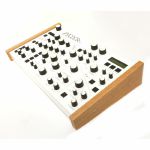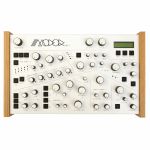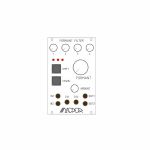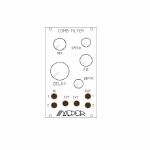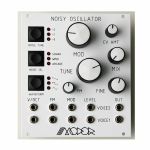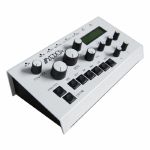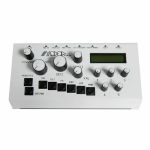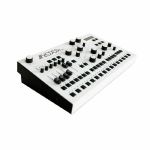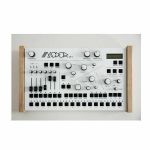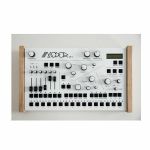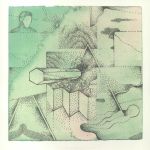100% Secure Shopping
Studio equipment
Our full range of studio equipment from all the leading equipment and software brands. Guaranteed fast delivery and low prices.
100% Secure Shopping
DJ equipment
Our full range of DJ equipment from all the leading equipment and software brands. Guaranteed fast delivery and low prices. Visit Juno DJ
Filter
Stock
Coming Soon
Music
Format
Brand
Label
Featured
Release Title
Price
Tags
Search results: modor
Items 1 to 10 of 10 on page 1 of 1
Modor NF-1 8-Voice Digital Desktop Synthesiser (white) (digital desktop synthesiser)
Cat: 603434 Rel: 06 Apr 16 • View all Synthesisers
Rackmountable 8 voice polyphonic digital desktop synthesiser with 448 patch memory (14 banks of 32 patches)
Notes: The Modor NF-1 synth is a digital DSP synth very comparable to the classic Virtual Analog synths, but Modor is moving further on from this point. We use the classic structure of VA-synths, with oscillators, filters and effects, with parameters that can be modulated using LFO's and envelopes. But every element has been rethought and reinvented. In a digital way.
The NF-1 has a classic 12dB/oct resonant filter, but we are also giving it a versatile formant filter, never seen in hardware before! It does make classic sawtooth waves, but we're also including a lot of other brand new modulatable noisy waveforms! It has a classic delay effect, but we make every parameter editable to give way to special unexpected effect types! And so on...
Oscillator section:
- 3 identical fully independent oscillators
- 10 waveforms:
- SAW: pulse width modulation sawtooth wave
- SQU: pulse width modulation pulse wave
- TRI: pulse width modulation triangle wave
- SYNC: sounding like a oscillator-synced wave
- ADD: additive harmonics
- SONAR: resonant bandpass filtered noise
- WIND: wind instrument noise
- ARC: arcade game style noise
- FM: sinus FM pair
- FBFM: feedback sinus FM pair
Filter section:
- 12dB/oct resonant filter switchable as lowpass, hipass, bandpass or bandstop (notch)
- Formant filter with 3 morphing vowels, 10 vowel presets and user controllable formant frequencies
Effects section:
- 'Comb filter' effect section to create chorus, flanger, ... effects
- Delay effect section to create echo effects
- All parameters can be set independently and are modulatable
Modulation section:
- 4 3-stage envelopes, 3 level settings and 4 time settings
- 2 switchable LFO's with TRI/SAW/SQU/SIN waveforms, 1 TRI-LFO connected to modwheel, 1 random S&H with lowpass option
- Modulation matrix with 7 user-defineable modulation wires,
- 16 source signals, 59 destination signals
UK Power adapter, wooden end panels & rack ears included
*For audio demos, please visit - https://soundcloud.com/modor-music
***NOW FEATURING THE FOLLOWING HARDWARE IMPROVEMENTS:
- Use of less 'wobbly', more stable feeling potentiometers
- Improved DAC gives a 12dB lower noise-floor
- Improved EMC-design (CE and FCC approval should follow soon)
- Line out is now capable of driving a headphone (Left line output doubles as stereo headphone out)
- MIDI USB connector has been added
… Read moreThe NF-1 has a classic 12dB/oct resonant filter, but we are also giving it a versatile formant filter, never seen in hardware before! It does make classic sawtooth waves, but we're also including a lot of other brand new modulatable noisy waveforms! It has a classic delay effect, but we make every parameter editable to give way to special unexpected effect types! And so on...
Oscillator section:
- 3 identical fully independent oscillators
- 10 waveforms:
- SAW: pulse width modulation sawtooth wave
- SQU: pulse width modulation pulse wave
- TRI: pulse width modulation triangle wave
- SYNC: sounding like a oscillator-synced wave
- ADD: additive harmonics
- SONAR: resonant bandpass filtered noise
- WIND: wind instrument noise
- ARC: arcade game style noise
- FM: sinus FM pair
- FBFM: feedback sinus FM pair
Filter section:
- 12dB/oct resonant filter switchable as lowpass, hipass, bandpass or bandstop (notch)
- Formant filter with 3 morphing vowels, 10 vowel presets and user controllable formant frequencies
Effects section:
- 'Comb filter' effect section to create chorus, flanger, ... effects
- Delay effect section to create echo effects
- All parameters can be set independently and are modulatable
Modulation section:
- 4 3-stage envelopes, 3 level settings and 4 time settings
- 2 switchable LFO's with TRI/SAW/SQU/SIN waveforms, 1 TRI-LFO connected to modwheel, 1 random S&H with lowpass option
- Modulation matrix with 7 user-defineable modulation wires,
- 16 source signals, 59 destination signals
UK Power adapter, wooden end panels & rack ears included
*For audio demos, please visit - https://soundcloud.com/modor-music
***NOW FEATURING THE FOLLOWING HARDWARE IMPROVEMENTS:
- Use of less 'wobbly', more stable feeling potentiometers
- Improved DAC gives a 12dB lower noise-floor
- Improved EMC-design (CE and FCC approval should follow soon)
- Line out is now capable of driving a headphone (Left line output doubles as stereo headphone out)
- MIDI USB connector has been added
out of stock $1,213.32
Modor Formant Filter Module (filter/digital synth module)
Cat: 677571 Rel: 28 Feb 18 • View all Synth modules
16HP Eurorack incarnation of the filter section from Modor's NF-1 digital polyphonic synthesiser
Notes: Modor's Formant Filter is a special filter that does a kind of 'vowel morphing' between three vowels. The big central FORMANT control is responsible for that, and on the Eurorack module there's of course a CV control (with attenuation) on this parameter.
You can imagine a formant filter as a set of parallel bandpass filters, picking up and amplifying a set of small frequency bands. For example, with these frequency bands around 750Hz, 1200Hz and 2800Hz, you get the sound of an 'A'. So far, nothing special. There are more formant filters around composed of a set of parallel bandpass filters.
It gets more interesting when you're able to 'morph' between different sets of those formant frequencies. Behind the central FORMANT control, there are 3 of those sets of frequencies. One at full left, one in the middle, and one fully right. So you can for example morph between A-E-O. Or U-I-E. Or AO-UI-EU. Or ...
That's what it does: morphing between different sets of formant frequencies, and that's why it sounds a lot more genuine vowel-ish than many other static bandpass combinators.
There are 10 preset vowels, that can be selected with the VOWEL button: A-E-O-I-OE-U-EI-EU-AO-U-UI. The vowels of the Dutch language... :-)
The 1-2-3-4 controls on top give you the possibility of composing your own vowels by manually adjusting the frequency bands.
… Read moreYou can imagine a formant filter as a set of parallel bandpass filters, picking up and amplifying a set of small frequency bands. For example, with these frequency bands around 750Hz, 1200Hz and 2800Hz, you get the sound of an 'A'. So far, nothing special. There are more formant filters around composed of a set of parallel bandpass filters.
It gets more interesting when you're able to 'morph' between different sets of those formant frequencies. Behind the central FORMANT control, there are 3 of those sets of frequencies. One at full left, one in the middle, and one fully right. So you can for example morph between A-E-O. Or U-I-E. Or AO-UI-EU. Or ...
That's what it does: morphing between different sets of formant frequencies, and that's why it sounds a lot more genuine vowel-ish than many other static bandpass combinators.
There are 10 preset vowels, that can be selected with the VOWEL button: A-E-O-I-OE-U-EI-EU-AO-U-UI. The vowels of the Dutch language... :-)
The 1-2-3-4 controls on top give you the possibility of composing your own vowels by manually adjusting the frequency bands.
out of stock $267.77
Modor Comb Filter Module (effect/filter synth module)
Cat: 700648 Rel: 18 Oct 18 • View all Synth modules
14HP Eurorack digital filter
Notes: What is a Comb Filter? It is a digital filter where the input signal is mixed with a slightly delayed version of the input signal. You won't hear it as some kind of an echo, as this delay is very short (40ms at max). But the mixing process creates a number of equally spaced peaks and holes in the frequency spectrum, that make it look like the teeth of a comb. That's where the name 'Comb Filter' comes from.
Comb filters are typically used to make chorus and flanger style effects. These effects are created by modulating the delay time. With longer and relatively fast modulated delays you receive a chorus effect. With short to very short slowly modulated delays, combined with some feedback you'll get the typical sound of a flanger unit.
So, the most interesting parameter in this is the delay time. That determines the frequency spacing of the comb teeth. So that's why there's a CV control for it. The typical chorus and flanger effects are made by modulating the delay time with a triangle LFO. So there's a triangle LFO onboard the module, with speed control. If you don't enter any CV in the CV1 connector, it is normalled to this internal LFO to make typical effects. CV2 is normalled to the reverse signal of CV1, to make Modor's typical wide stereo effects, just as on the NF-1 synthesizer. But of course, you can enter your own CV signals in there: LFO's, Envelopes or some rhythmically undulating spacy voltage signals...
The centre big DELAY control sets the delay time, the DEPTH control sets the amount of CV modulation of the delay time. DEPTH can go positive and negative.
The MIX control sets the dry/wet mix. The FEEDBACK controls the amount of feedback. It can be set both positive and negative. The SPEED control sets the pace of the internal triangle LFO.
… Read moreComb filters are typically used to make chorus and flanger style effects. These effects are created by modulating the delay time. With longer and relatively fast modulated delays you receive a chorus effect. With short to very short slowly modulated delays, combined with some feedback you'll get the typical sound of a flanger unit.
So, the most interesting parameter in this is the delay time. That determines the frequency spacing of the comb teeth. So that's why there's a CV control for it. The typical chorus and flanger effects are made by modulating the delay time with a triangle LFO. So there's a triangle LFO onboard the module, with speed control. If you don't enter any CV in the CV1 connector, it is normalled to this internal LFO to make typical effects. CV2 is normalled to the reverse signal of CV1, to make Modor's typical wide stereo effects, just as on the NF-1 synthesizer. But of course, you can enter your own CV signals in there: LFO's, Envelopes or some rhythmically undulating spacy voltage signals...
The centre big DELAY control sets the delay time, the DEPTH control sets the amount of CV modulation of the delay time. DEPTH can go positive and negative.
The MIX control sets the dry/wet mix. The FEEDBACK controls the amount of feedback. It can be set both positive and negative. The SPEED control sets the pace of the internal triangle LFO.
out of stock $242.86
Modor Noisy Oscillator Module (noise/oscillator synth module)
Cat: 733645 Rel: 29 May 19 • View all Synth modules
Complex oscillation module - 22HP
Notes: The Noisy Oscillator module is an oscillator that mixes two signals: a 'regular' wave (sawtooth/square/triangle) and a 'tonal noisy' wave. This adds a special noisy layer over the sound, that adds 'air', grit or dirt, depending on the combinations you make. The MOD parameter acts on the noisy waveforms:
- Sonar Noise: a white noise filtered by a resonant bandpass filter, with 1V/oct tracking of the filter frequency. The MOD parameter controls the resonance.
- Wind Noise: white noise filtered by a comb filter, with 1V/oct tracking of the base frequency (delay). The MOD parameter controls a 6dB/oct hipass filter.
- Arcade Noise: LFSR noise source as can be found on the SID soundchips (Commodore) or Sega Arcade games. The MOD parameter controls again a 6dB/oct hipass filter.
The noisy wave can be set equal, or 1 or 2 octaves above the regular wave.
The module has two voices, with their own set of CV and output connectors. This can be used to play in a full 2-voice polyphony, or in a 2-voice unison. The outputs can be separate, using both output connectors, or mixed, using only the connector of the second voice.
Next to the 1V/oct pitch CV, the module offers CV control over pitch (FM), the MOD parameter and the sound level:
- FM CV: pitch control normalled to 0V, attenuated with the FM knob (+ and -). This allows for Frequency Modulation up to the lower audio range. It's of course a digital module, so higher frequencies can start inducing aliasing and digital artefacts.
- MOD CV: CV control for the MOD parameter, normalled to 0V and attenuated with the CV AMT knob (+ and -).
- LEVEL CV: CV control for the sound volume, normalled to 7.5V. With this CV control you can omit an external VCA stage if you want.
The CV signals of the second voice (upper row of connectors) are always normalled to the signal of the first voice (lower row), so you can use a single LFO for some FM vibrato or tremolo on both voices, for example. Only the V/oct connector of the second voice is normalled to the first voice with an extra addition of a fixed voltage that can be set using a trimmer at the backside of the module. This way you can use the 2 voices to play in unison with a fixed pitch separation you can set on the backside.
… Read more- Sonar Noise: a white noise filtered by a resonant bandpass filter, with 1V/oct tracking of the filter frequency. The MOD parameter controls the resonance.
- Wind Noise: white noise filtered by a comb filter, with 1V/oct tracking of the base frequency (delay). The MOD parameter controls a 6dB/oct hipass filter.
- Arcade Noise: LFSR noise source as can be found on the SID soundchips (Commodore) or Sega Arcade games. The MOD parameter controls again a 6dB/oct hipass filter.
The noisy wave can be set equal, or 1 or 2 octaves above the regular wave.
The module has two voices, with their own set of CV and output connectors. This can be used to play in a full 2-voice polyphony, or in a 2-voice unison. The outputs can be separate, using both output connectors, or mixed, using only the connector of the second voice.
Next to the 1V/oct pitch CV, the module offers CV control over pitch (FM), the MOD parameter and the sound level:
- FM CV: pitch control normalled to 0V, attenuated with the FM knob (+ and -). This allows for Frequency Modulation up to the lower audio range. It's of course a digital module, so higher frequencies can start inducing aliasing and digital artefacts.
- MOD CV: CV control for the MOD parameter, normalled to 0V and attenuated with the CV AMT knob (+ and -).
- LEVEL CV: CV control for the sound volume, normalled to 7.5V. With this CV control you can omit an external VCA stage if you want.
The CV signals of the second voice (upper row of connectors) are always normalled to the signal of the first voice (lower row), so you can use a single LFO for some FM vibrato or tremolo on both voices, for example. Only the V/oct connector of the second voice is normalled to the first voice with an extra addition of a fixed voltage that can be set using a trimmer at the backside of the module. This way you can use the 2 voices to play in unison with a fixed pitch separation you can set on the backside.
out of stock $268.82
Modor NF-1m Minimodor Digital Desktop Synthesiser (white) (digital desktop synthesiser)
Cat: 648919 Rel: 31 May 17 • View all Synthesisers
Polyphonic digital desktop synthesiser - smaller version of the original Modor NF1
Notes: The original Modor NF-1 has one main disadvantage: it's quite big and heavy. Not your favourite piece of hand luggage to carry around. So, here is the smaller, portable version. And of course, a smaller device means a smaller price...!
This comes of course with a smaller number of front panel controls... The Modor NF-1m has 7 context dependant controls grouped in 15 edit pages with a set of 6 pushbuttons to access these pages quickly. Every parameter is just a button press away!
Not unimportant, the NF-1m has new rotary controls with a more stable feeling than the controls on the original NF-1.
Next to that, there are 2 large 'definable controls', DEF1 and DEF2. These controls can be assigned to any sound parameter so that you can 'preselect' two parameters in every patch to have a permanent dedicated control on the front panel. This makes it easy to access your favourite parameters, no matter in which edit page you are...
… Read moreThis comes of course with a smaller number of front panel controls... The Modor NF-1m has 7 context dependant controls grouped in 15 edit pages with a set of 6 pushbuttons to access these pages quickly. Every parameter is just a button press away!
Not unimportant, the NF-1m has new rotary controls with a more stable feeling than the controls on the original NF-1.
Next to that, there are 2 large 'definable controls', DEF1 and DEF2. These controls can be assigned to any sound parameter so that you can 'preselect' two parameters in every patch to have a permanent dedicated control on the front panel. This makes it easy to access your favourite parameters, no matter in which edit page you are...
out of stock $516.88
Modor NF-1m Minimodor Digital Desktop Synthesiser (white) (B-STOCK) (digital desktop synthesiser)
Cat: 918072 Rel: 31 May 17 • View all Synthesisers
B-STOCK: Item refurbished, repaired and in perfect working order.
Notes: ***B-STOCK: Item refurbished, repaired and in perfect working order.***
The original Modor NF-1 has one main disadvantage: it's quite big and heavy. Not your favourite piece of hand luggage to carry around. So, here is the smaller, portable version. And of course, a smaller device means a smaller price...!
This comes of course with a smaller number of front panel controls... The Modor NF-1m has 7 context dependant controls grouped in 15 edit pages with a set of 6 pushbuttons to access these pages quickly. Every parameter is just a button press away!
Not unimportant, the NF-1m has new rotary controls with a more stable feeling than the controls on the original NF-1.
Next to that, there are 2 large 'definable controls', DEF1 and DEF2. These controls can be assigned to any sound parameter so that you can 'preselect' two parameters in every patch to have a permanent dedicated control on the front panel. This makes it easy to access your favourite parameters, no matter in which edit page you are...
… Read moreThe original Modor NF-1 has one main disadvantage: it's quite big and heavy. Not your favourite piece of hand luggage to carry around. So, here is the smaller, portable version. And of course, a smaller device means a smaller price...!
This comes of course with a smaller number of front panel controls... The Modor NF-1m has 7 context dependant controls grouped in 15 edit pages with a set of 6 pushbuttons to access these pages quickly. Every parameter is just a button press away!
Not unimportant, the NF-1m has new rotary controls with a more stable feeling than the controls on the original NF-1.
Next to that, there are 2 large 'definable controls', DEF1 and DEF2. These controls can be assigned to any sound parameter so that you can 'preselect' two parameters in every patch to have a permanent dedicated control on the front panel. This makes it easy to access your favourite parameters, no matter in which edit page you are...
out of stock $496.10
Cat: 993692 Rel: 01 Jan 90 • View all Drum machines
B-STOCK: Item refurbished, repaired and in perfect working order.
Notes: ***B-STOCK: Item refurbished, repaired and in perfect working order.***
Killer digital drum machine from the excellent Modor. Six instruments, 128-step sequencer and some of the freshest, most innovative drum sounds we've heard in a long time.
*** New upgrade - July 2023 ***
Introducing this new upgrade for the DR-2, OS010. Built in cooperation with Berlin-based Canadian electronic music artist Nicolas Bougaieff!
Bougaieff frequently uses polyrhythmic structures, dividing bars or musical phrases of different instruments into different numbers of steps. Have one instrument play 17 steps in the time another instrument plays only 16 steps, or 8 steps in 5 steps, or... Like stretching N steps of one instrument over M steps of a second one, giving them an N:M speed ratio.
He felt that there were only rather limited possibilities in hardware sequencers and drum machines to achieve this.
The process of achieving this was quite challenging, but the result was worth it! This is a very intuitive way to work with polyrhythms, making use of stretched clocks. It is ready for download now on Modor's download page on their site!
Apart from the main sequencer clock, the DR-2 now has 2 polyrhythmic clocks (or 'polyclocks'), called polyclock A and B. Each of these 2 clocks relates to the regular 'main' clock with a certain N:M ratio. The polyclock takes N steps in the time the main clock takes M steps.
Next, every instrument can separately choose a clock:
the main clock,
the A polyrhythmic clock,
or the B polyrhythmic clock.
This means, you can let, for example, a snaredrum play 7 steps while the rest of the instruments plays 8 steps. The 7 steps are stretched equally in time over the 8 steps of the other instruments.
How is this done?
Keep the A or B button down, and set the N:M ratio using the SELECT/BPM (for N) and VALUE/SWING (for M) knobs.
Keep an instrument button A...F down and hit the A or B button to assign that instrument to one of the polyrhythmic clocks. Hit it again to return to the main clock.
Supplier's Notes:
The DR-2 is a 6 instrument digital DSP drum synth, with a built-in 128-step drum sequencer. At first sight, it will feel recognizable in some ways. There are sounds that will remind you of the good old classic drum machines, and the step sequencer will get you building drum riffs from the first second you touch it. But Modor uses digital sound synthesis to get beyond the possibilities of a classic drum machine, and the step sequencer does more than just hitting drums...
First of all: although it's digital, the DR-2 is not about sampling. It's a drum synthesizer, like a classic analog drum machine, but it uses digital sound synthesis algorithms instead of analog circuitry. There are no samples in the DR-2, and there's no sample memory.
Just like the Modor NF-1, the DR-2 is not built to recreate the classics of the past. The DR-2 uses digital sound synthesis to innovate drum sounds and rhythms. Many sounds will be recognizable. It is possible to make classic sounding bass drums, snares and rimshots. It's not difficult to program classic floorfillers with the DR-2. But with 12 synthesis parameters per drum, you'll easily find yourself creating your own individual sound.
The DR-2 has 6 drum 'channels', drumsets made of 6 drum instruments. These channels don't have predefined instruments. You can choose freely which instruments you want in your 6-channel drumsets. The DR-2 works with drum 'models', of which you can pick one for every channel. You can consider these 'models', or synthesis algorithms, as a collection of small but dedicated drum synthesizers, of which you can pick 6 to form a drumset. There are models for bass drums, snares and cymbals, but also for some more unusual drum sounds, clicks and ticks.
Every model has up to 12 sound synthesis parameters: Pitch with pitch decay, curve and amount, amp volume with panning, amp decay and curve, and parameters X, Y, Z and T that have a different function in every model, see the table below.
The DR-2 has an output jack connector for each of the 6 channels A-F, and 2 master L/R outputs. If there's no cable connected to a channel output, the corresponding channel is sent to the master L/R outputs. The individual channel outputs are mono, but have a panning parameter to give it a stereo position in the master mix.
But there is more! The A-F output connectors are actually insert points, you can use 6.35mm (1/4") TRS jack connectors to route a channel out of the DR-2, and send it back in if you want. This way, you can use external effects, equalisers, compressors, ... on each of the 6 channels individually, and still have them panned and mixed in the master outputs of the DR-2.
Next to the audio connectors, the DR-2 has 6.35mm (1/4") TS connectors for 24PPQN clock input and output, and has classic din-5 MIDI IN, OUT and THRU connectors.
The sequencer of the DR-2 has a lot more options than just the classic 16-step sequencer. First of all: you can use 32nd notes, so the DR-2 doubles the resolution of a classic 16-step sequencer. The DR-2 has 16 step buttons but you can see 32 step leds on the front panel. Keep the '16/32'-button pressed to access the steps-between-the-steps.
A pattern can use up to 4 of these 16/32-step pattern parts, these can be accessed with the 1-16/17-32/33-48/49-64 buttons. Using SHIFT + one of these buttons sets the pattern length. So, it's actually a 4x32 or 128-step sequencer.
But there's more: each instrument has it's own Accent, Flam, Tuplet, Break and Reverse patterns. Keep the ACC, FLAM, SHIFT+FLAM, BREAK or REV button pressed while using the step buttons.
MEASUREMENTS
Width: 440mm without rack ears, 480mm with rack ears (19")
Height: 267mm (10.5"/ 6U)
Depth: 40mm (front) - 80mm (back)
Weight: +/- 6kg
CONNECTIONS
9V, 600mA adapter connection, positive voltage on center pin
MIDI IN/THRU/OUT connections, 3x 5-pin DIN connection
Clock In/Out connections, 2x 6.35mm mono jack
Audio Instrument Outputs/Inserts, 6x 6.35mm TRS or mono jack, unbalanced
Audio Left/Stereo output, 6.35mm TRS or mono jack, unbalanced, capable of driving headphones
Audio Right output, 6.35mm mono jack, unbalanced
… Read moreKiller digital drum machine from the excellent Modor. Six instruments, 128-step sequencer and some of the freshest, most innovative drum sounds we've heard in a long time.
*** New upgrade - July 2023 ***
Introducing this new upgrade for the DR-2, OS010. Built in cooperation with Berlin-based Canadian electronic music artist Nicolas Bougaieff!
Bougaieff frequently uses polyrhythmic structures, dividing bars or musical phrases of different instruments into different numbers of steps. Have one instrument play 17 steps in the time another instrument plays only 16 steps, or 8 steps in 5 steps, or... Like stretching N steps of one instrument over M steps of a second one, giving them an N:M speed ratio.
He felt that there were only rather limited possibilities in hardware sequencers and drum machines to achieve this.
The process of achieving this was quite challenging, but the result was worth it! This is a very intuitive way to work with polyrhythms, making use of stretched clocks. It is ready for download now on Modor's download page on their site!
Apart from the main sequencer clock, the DR-2 now has 2 polyrhythmic clocks (or 'polyclocks'), called polyclock A and B. Each of these 2 clocks relates to the regular 'main' clock with a certain N:M ratio. The polyclock takes N steps in the time the main clock takes M steps.
Next, every instrument can separately choose a clock:
the main clock,
the A polyrhythmic clock,
or the B polyrhythmic clock.
This means, you can let, for example, a snaredrum play 7 steps while the rest of the instruments plays 8 steps. The 7 steps are stretched equally in time over the 8 steps of the other instruments.
How is this done?
Keep the A or B button down, and set the N:M ratio using the SELECT/BPM (for N) and VALUE/SWING (for M) knobs.
Keep an instrument button A...F down and hit the A or B button to assign that instrument to one of the polyrhythmic clocks. Hit it again to return to the main clock.
Supplier's Notes:
The DR-2 is a 6 instrument digital DSP drum synth, with a built-in 128-step drum sequencer. At first sight, it will feel recognizable in some ways. There are sounds that will remind you of the good old classic drum machines, and the step sequencer will get you building drum riffs from the first second you touch it. But Modor uses digital sound synthesis to get beyond the possibilities of a classic drum machine, and the step sequencer does more than just hitting drums...
First of all: although it's digital, the DR-2 is not about sampling. It's a drum synthesizer, like a classic analog drum machine, but it uses digital sound synthesis algorithms instead of analog circuitry. There are no samples in the DR-2, and there's no sample memory.
Just like the Modor NF-1, the DR-2 is not built to recreate the classics of the past. The DR-2 uses digital sound synthesis to innovate drum sounds and rhythms. Many sounds will be recognizable. It is possible to make classic sounding bass drums, snares and rimshots. It's not difficult to program classic floorfillers with the DR-2. But with 12 synthesis parameters per drum, you'll easily find yourself creating your own individual sound.
The DR-2 has 6 drum 'channels', drumsets made of 6 drum instruments. These channels don't have predefined instruments. You can choose freely which instruments you want in your 6-channel drumsets. The DR-2 works with drum 'models', of which you can pick one for every channel. You can consider these 'models', or synthesis algorithms, as a collection of small but dedicated drum synthesizers, of which you can pick 6 to form a drumset. There are models for bass drums, snares and cymbals, but also for some more unusual drum sounds, clicks and ticks.
Every model has up to 12 sound synthesis parameters: Pitch with pitch decay, curve and amount, amp volume with panning, amp decay and curve, and parameters X, Y, Z and T that have a different function in every model, see the table below.
The DR-2 has an output jack connector for each of the 6 channels A-F, and 2 master L/R outputs. If there's no cable connected to a channel output, the corresponding channel is sent to the master L/R outputs. The individual channel outputs are mono, but have a panning parameter to give it a stereo position in the master mix.
But there is more! The A-F output connectors are actually insert points, you can use 6.35mm (1/4") TRS jack connectors to route a channel out of the DR-2, and send it back in if you want. This way, you can use external effects, equalisers, compressors, ... on each of the 6 channels individually, and still have them panned and mixed in the master outputs of the DR-2.
Next to the audio connectors, the DR-2 has 6.35mm (1/4") TS connectors for 24PPQN clock input and output, and has classic din-5 MIDI IN, OUT and THRU connectors.
The sequencer of the DR-2 has a lot more options than just the classic 16-step sequencer. First of all: you can use 32nd notes, so the DR-2 doubles the resolution of a classic 16-step sequencer. The DR-2 has 16 step buttons but you can see 32 step leds on the front panel. Keep the '16/32'-button pressed to access the steps-between-the-steps.
A pattern can use up to 4 of these 16/32-step pattern parts, these can be accessed with the 1-16/17-32/33-48/49-64 buttons. Using SHIFT + one of these buttons sets the pattern length. So, it's actually a 4x32 or 128-step sequencer.
But there's more: each instrument has it's own Accent, Flam, Tuplet, Break and Reverse patterns. Keep the ACC, FLAM, SHIFT+FLAM, BREAK or REV button pressed while using the step buttons.
MEASUREMENTS
Width: 440mm without rack ears, 480mm with rack ears (19")
Height: 267mm (10.5"/ 6U)
Depth: 40mm (front) - 80mm (back)
Weight: +/- 6kg
CONNECTIONS
9V, 600mA adapter connection, positive voltage on center pin
MIDI IN/THRU/OUT connections, 3x 5-pin DIN connection
Clock In/Out connections, 2x 6.35mm mono jack
Audio Instrument Outputs/Inserts, 6x 6.35mm TRS or mono jack, unbalanced
Audio Left/Stereo output, 6.35mm TRS or mono jack, unbalanced, capable of driving headphones
Audio Right output, 6.35mm mono jack, unbalanced
1 in stock $1,501.74
Modor DR-2 6-Instruments Digital DSP Drum Synthesiser (drum machine)
Cat: 800419 Rel: 17 Nov 20 • View all Drum machines
6-instrument digital drum machine
Notes: Killer digital drum machine from the excellent Modor. Six instruments, 128-step sequencer and some of the freshest, most innovative drum sounds we've heard in a long time.
*** New upgrade - July 2023 ***
Introducing this new upgrade for the DR-2, OS010. Built in cooperation with Berlin-based Canadian electronic music artist Nicolas Bougaieff!
Bougaieff frequently uses polyrhythmic structures, dividing bars or musical phrases of different instruments into different numbers of steps. Have one instrument play 17 steps in the time another instrument plays only 16 steps, or 8 steps in 5 steps, or... Like stretching N steps of one instrument over M steps of a second one, giving them an N:M speed ratio.
He felt that there were only rather limited possibilities in hardware sequencers and drum machines to achieve this.
The process of achieving this was quite challenging, but the result was worth it! This is a very intuitive way to work with polyrhythms, making use of stretched clocks. It is ready for download now on Modor's download page on their site!
Apart from the main sequencer clock, the DR-2 now has 2 polyrhythmic clocks (or 'polyclocks'), called polyclock A and B. Each of these 2 clocks relates to the regular 'main' clock with a certain N:M ratio. The polyclock takes N steps in the time the main clock takes M steps.
Next, every instrument can separately choose a clock:
the main clock,
the A polyrhythmic clock,
or the B polyrhythmic clock.
This means, you can let, for example, a snaredrum play 7 steps while the rest of the instruments plays 8 steps. The 7 steps are stretched equally in time over the 8 steps of the other instruments.
How is this done?
Keep the A or B button down, and set the N:M ratio using the SELECT/BPM (for N) and VALUE/SWING (for M) knobs.
Keep an instrument button A...F down and hit the A or B button to assign that instrument to one of the polyrhythmic clocks. Hit it again to return to the main clock.
Supplier's Notes:
The DR-2 is a 6 instrument digital DSP drum synth, with a built-in 128-step drum sequencer. At first sight, it will feel recognizable in some ways. There are sounds that will remind you of the good old classic drum machines, and the step sequencer will get you building drum riffs from the first second you touch it. But Modor uses digital sound synthesis to get beyond the possibilities of a classic drum machine, and the step sequencer does more than just hitting drums...
First of all: although it's digital, the DR-2 is not about sampling. It's a drum synthesizer, like a classic analog drum machine, but it uses digital sound synthesis algorithms instead of analog circuitry. There are no samples in the DR-2, and there's no sample memory.
Just like the Modor NF-1, the DR-2 is not built to recreate the classics of the past. The DR-2 uses digital sound synthesis to innovate drum sounds and rhythms. Many sounds will be recognizable. It is possible to make classic sounding bass drums, snares and rimshots. It's not difficult to program classic floorfillers with the DR-2. But with 12 synthesis parameters per drum, you'll easily find yourself creating your own individual sound.
The DR-2 has 6 drum 'channels', drumsets made of 6 drum instruments. These channels don't have predefined instruments. You can choose freely which instruments you want in your 6-channel drumsets. The DR-2 works with drum 'models', of which you can pick one for every channel. You can consider these 'models', or synthesis algorithms, as a collection of small but dedicated drum synthesizers, of which you can pick 6 to form a drumset. There are models for bass drums, snares and cymbals, but also for some more unusual drum sounds, clicks and ticks.
Every model has up to 12 sound synthesis parameters: Pitch with pitch decay, curve and amount, amp volume with panning, amp decay and curve, and parameters X, Y, Z and T that have a different function in every model, see the table below.
The DR-2 has an output jack connector for each of the 6 channels A-F, and 2 master L/R outputs. If there's no cable connected to a channel output, the corresponding channel is sent to the master L/R outputs. The individual channel outputs are mono, but have a panning parameter to give it a stereo position in the master mix.
But there is more! The A-F output connectors are actually insert points, you can use 6.35mm (1/4") TRS jack connectors to route a channel out of the DR-2, and send it back in if you want. This way, you can use external effects, equalisers, compressors, ... on each of the 6 channels individually, and still have them panned and mixed in the master outputs of the DR-2.
Next to the audio connectors, the DR-2 has 6.35mm (1/4") TS connectors for 24PPQN clock input and output, and has classic din-5 MIDI IN, OUT and THRU connectors.
The sequencer of the DR-2 has a lot more options than just the classic 16-step sequencer. First of all: you can use 32nd notes, so the DR-2 doubles the resolution of a classic 16-step sequencer. The DR-2 has 16 step buttons but you can see 32 step leds on the front panel. Keep the '16/32'-button pressed to access the steps-between-the-steps.
A pattern can use up to 4 of these 16/32-step pattern parts, these can be accessed with the 1-16/17-32/33-48/49-64 buttons. Using SHIFT + one of these buttons sets the pattern length. So, it's actually a 4x32 or 128-step sequencer.
But there's more: each instrument has it's own Accent, Flam, Tuplet, Break and Reverse patterns. Keep the ACC, FLAM, SHIFT+FLAM, BREAK or REV button pressed while using the step buttons.
MEASUREMENTS
Width: 440mm without rack ears, 480mm with rack ears (19")
Height: 267mm (10.5"/ 6U)
Depth: 40mm (front) - 80mm (back)
Weight: +/- 6kg
CONNECTIONS
9V, 600mA adapter connection, positive voltage on center pin
MIDI IN/THRU/OUT connections, 3x 5-pin DIN connection
Clock In/Out connections, 2x 6.35mm mono jack
Audio Instrument Outputs/Inserts, 6x 6.35mm TRS or mono jack, unbalanced
Audio Left/Stereo output, 6.35mm TRS or mono jack, unbalanced, capable of driving headphones
Audio Right output, 6.35mm mono jack, unbalanced
… Read more*** New upgrade - July 2023 ***
Introducing this new upgrade for the DR-2, OS010. Built in cooperation with Berlin-based Canadian electronic music artist Nicolas Bougaieff!
Bougaieff frequently uses polyrhythmic structures, dividing bars or musical phrases of different instruments into different numbers of steps. Have one instrument play 17 steps in the time another instrument plays only 16 steps, or 8 steps in 5 steps, or... Like stretching N steps of one instrument over M steps of a second one, giving them an N:M speed ratio.
He felt that there were only rather limited possibilities in hardware sequencers and drum machines to achieve this.
The process of achieving this was quite challenging, but the result was worth it! This is a very intuitive way to work with polyrhythms, making use of stretched clocks. It is ready for download now on Modor's download page on their site!
Apart from the main sequencer clock, the DR-2 now has 2 polyrhythmic clocks (or 'polyclocks'), called polyclock A and B. Each of these 2 clocks relates to the regular 'main' clock with a certain N:M ratio. The polyclock takes N steps in the time the main clock takes M steps.
Next, every instrument can separately choose a clock:
the main clock,
the A polyrhythmic clock,
or the B polyrhythmic clock.
This means, you can let, for example, a snaredrum play 7 steps while the rest of the instruments plays 8 steps. The 7 steps are stretched equally in time over the 8 steps of the other instruments.
How is this done?
Keep the A or B button down, and set the N:M ratio using the SELECT/BPM (for N) and VALUE/SWING (for M) knobs.
Keep an instrument button A...F down and hit the A or B button to assign that instrument to one of the polyrhythmic clocks. Hit it again to return to the main clock.
Supplier's Notes:
The DR-2 is a 6 instrument digital DSP drum synth, with a built-in 128-step drum sequencer. At first sight, it will feel recognizable in some ways. There are sounds that will remind you of the good old classic drum machines, and the step sequencer will get you building drum riffs from the first second you touch it. But Modor uses digital sound synthesis to get beyond the possibilities of a classic drum machine, and the step sequencer does more than just hitting drums...
First of all: although it's digital, the DR-2 is not about sampling. It's a drum synthesizer, like a classic analog drum machine, but it uses digital sound synthesis algorithms instead of analog circuitry. There are no samples in the DR-2, and there's no sample memory.
Just like the Modor NF-1, the DR-2 is not built to recreate the classics of the past. The DR-2 uses digital sound synthesis to innovate drum sounds and rhythms. Many sounds will be recognizable. It is possible to make classic sounding bass drums, snares and rimshots. It's not difficult to program classic floorfillers with the DR-2. But with 12 synthesis parameters per drum, you'll easily find yourself creating your own individual sound.
The DR-2 has 6 drum 'channels', drumsets made of 6 drum instruments. These channels don't have predefined instruments. You can choose freely which instruments you want in your 6-channel drumsets. The DR-2 works with drum 'models', of which you can pick one for every channel. You can consider these 'models', or synthesis algorithms, as a collection of small but dedicated drum synthesizers, of which you can pick 6 to form a drumset. There are models for bass drums, snares and cymbals, but also for some more unusual drum sounds, clicks and ticks.
Every model has up to 12 sound synthesis parameters: Pitch with pitch decay, curve and amount, amp volume with panning, amp decay and curve, and parameters X, Y, Z and T that have a different function in every model, see the table below.
The DR-2 has an output jack connector for each of the 6 channels A-F, and 2 master L/R outputs. If there's no cable connected to a channel output, the corresponding channel is sent to the master L/R outputs. The individual channel outputs are mono, but have a panning parameter to give it a stereo position in the master mix.
But there is more! The A-F output connectors are actually insert points, you can use 6.35mm (1/4") TRS jack connectors to route a channel out of the DR-2, and send it back in if you want. This way, you can use external effects, equalisers, compressors, ... on each of the 6 channels individually, and still have them panned and mixed in the master outputs of the DR-2.
Next to the audio connectors, the DR-2 has 6.35mm (1/4") TS connectors for 24PPQN clock input and output, and has classic din-5 MIDI IN, OUT and THRU connectors.
The sequencer of the DR-2 has a lot more options than just the classic 16-step sequencer. First of all: you can use 32nd notes, so the DR-2 doubles the resolution of a classic 16-step sequencer. The DR-2 has 16 step buttons but you can see 32 step leds on the front panel. Keep the '16/32'-button pressed to access the steps-between-the-steps.
A pattern can use up to 4 of these 16/32-step pattern parts, these can be accessed with the 1-16/17-32/33-48/49-64 buttons. Using SHIFT + one of these buttons sets the pattern length. So, it's actually a 4x32 or 128-step sequencer.
But there's more: each instrument has it's own Accent, Flam, Tuplet, Break and Reverse patterns. Keep the ACC, FLAM, SHIFT+FLAM, BREAK or REV button pressed while using the step buttons.
MEASUREMENTS
Width: 440mm without rack ears, 480mm with rack ears (19")
Height: 267mm (10.5"/ 6U)
Depth: 40mm (front) - 80mm (back)
Weight: +/- 6kg
CONNECTIONS
9V, 600mA adapter connection, positive voltage on center pin
MIDI IN/THRU/OUT connections, 3x 5-pin DIN connection
Clock In/Out connections, 2x 6.35mm mono jack
Audio Instrument Outputs/Inserts, 6x 6.35mm TRS or mono jack, unbalanced
Audio Left/Stereo output, 6.35mm TRS or mono jack, unbalanced, capable of driving headphones
Audio Right output, 6.35mm mono jack, unbalanced
2 in stock $1,566.22
Green Mirror (2xLP + insert + MP3 download code)
Cat: INVINC 33LP. Rel: 12 Apr 23
Experimental/Electronic
Review: Eddie Ruscha is always a reliable source for sublime electronic escapades beamed in from his uniquely sunny sound world. It's an idiosyncratic style best captured on his Secret Circuit alias, which makes a welcome return with the first new album since 2016's limited CD release Mind Bowling. This time he's shoring up on Invisible Inc. with an expansive sketch pad of tripped out delights, leaning in on dub processes and making the myriad synth patterns perform acrobatic feats over each other for 21 tracks of neo-psychedelia with a potent tropical slant.
… Read more in stock $23.35
Evangelion Finally (Soundtrack) (limited blue splattered vinyl 2xLP + insert)
Cat: 194398 44351. Rel: 11 May 21
Soundtracks
Review: Evangelion Finally is a collection of vocal songs performed by Yoko Takahashi and Megumi Hayashibara from the anime series Neon Genesis Evangelion, and Evangelion 2.0 You Can (Not) Advance - marking the 25th anniversary of the series' debut. It is also just in time for the release of Shin Evangelion, coming soon to cinemas this year. Features Takahashi's theme song 'The Cruel Angel's Thesis' as well as a new cover of 'Fly Me To The Moon' (2020 Version) featured in the show's ending credits. A new original track comes in the form of 'Thanatos - If I Can't Be Yours' - the theme song for the new feature film - performed by Loren & Mash (formed by British singer Lorrain Briscoe with Martin Lascelles and Evangelion composer Shiro Sagisu) in addition to the legendary masterpiece 'Come Sweet Death, Second Impact' - which is reworked as a jazz arrangement featuring Hayashibara on vocals.
… Read moreout of stock $30.09
Items 1 to 10 of 10 on page 1 of 1




